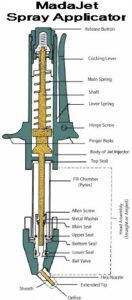The patients always wonder how the Easy Vasectomy Reversal is performed without a scalpel and no initial skin injection. This blog explains it.
Conventional needle anesthesia in vasectomy Reversal involves the use of a 27 gauge needle to raise a wheal at the skin of scrotum; it is then advanced its full length along the vas on each side and the deep tissue where further anesthetic solution is deposited. Dr. Shu uses the modern minimal invasive technique, exposing each vas in turn through a tiny opening in the front scrotal wall under local anesthesia. The initial local anesthesia is applied without the use of needles. A spray applicator (MadaJet®) delivers a stream of anesthetic so fine that it penetrates the skin and diffuses to a depth of about 3/16 of an inch, enough to surround and anesthetize each vas tube in turn as it is lifted into position beneath the skin. The initial numbing medication is usually enough for skin incision and vas lifting. Once the vas is identified and lifted, additional anesthetic is given to reach 100% painless effect during the whole procedure.
No-scalpel vasectomy instruments were originally developed by Dr. Shungiang Li, in China in the mid-70’s and introduced into the United States in 1989. Many years ago, Dr. Steven Shu innovatively improved his surgical techniques on vasectomy reversal procedure (vasovasostomy) by using the same principles and no-scalpel instruments.
A vasectomy reversal (vasovasostomy) is a microsurgical procedure that reconnects the vas deferens where it was interrupted by a vasectomy. A traditional approach to vasectomy reversal is to make two big incisions in each side of scrotum. Over the past decade, more surgeons adopted a single incision in the middle of the scrotum. In order to further reduce the trauma, the recovery time, the operative time, and the postoperative complications, the mini incision vasectomy reversal approach was proposed. Similar to no-scalpel vasectomy, the initial mini-incision is created using a sharp penetrating forceps that spreads the tissue apart instead of cutting it with a sharp scalpel.
Dr. Shu uses two important no-scalpel instruments to perform the vasectomy reversal procedure. They are simply a very pointy hemostat, used initially to make a tiny opening into anesthetized skin of the scrotal wall, and a ring clamp, used initially to secure each vas tube in turn beneath this opening.
The refined techniques of no-scalpel Easy vasectomy reversalⓇ minimize trauma, pain and complications. The introduction of no-scalpel Easy vasectomy reversalⓇ has successfully allayed many men’s fears with regard to the scalpel.








